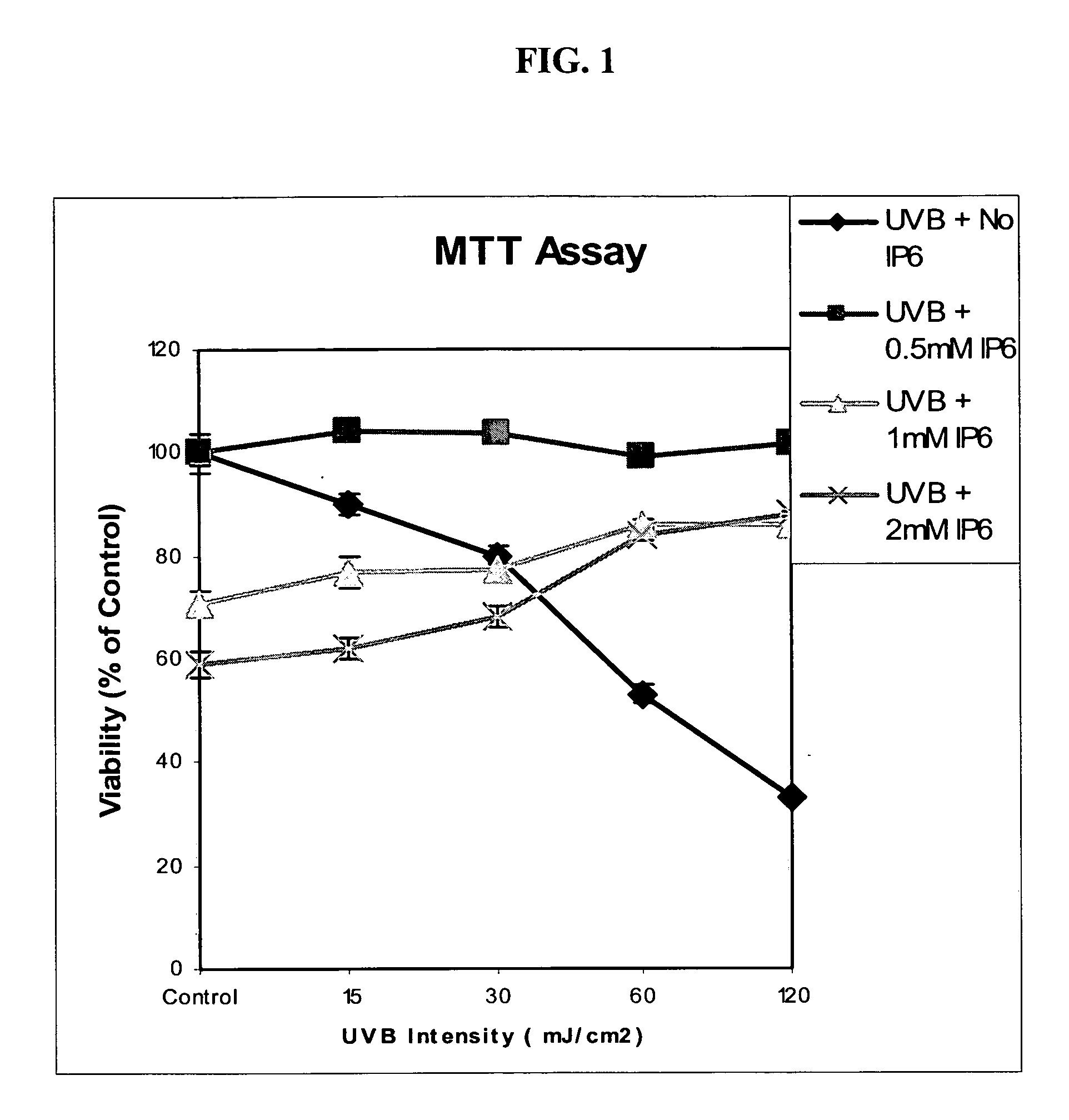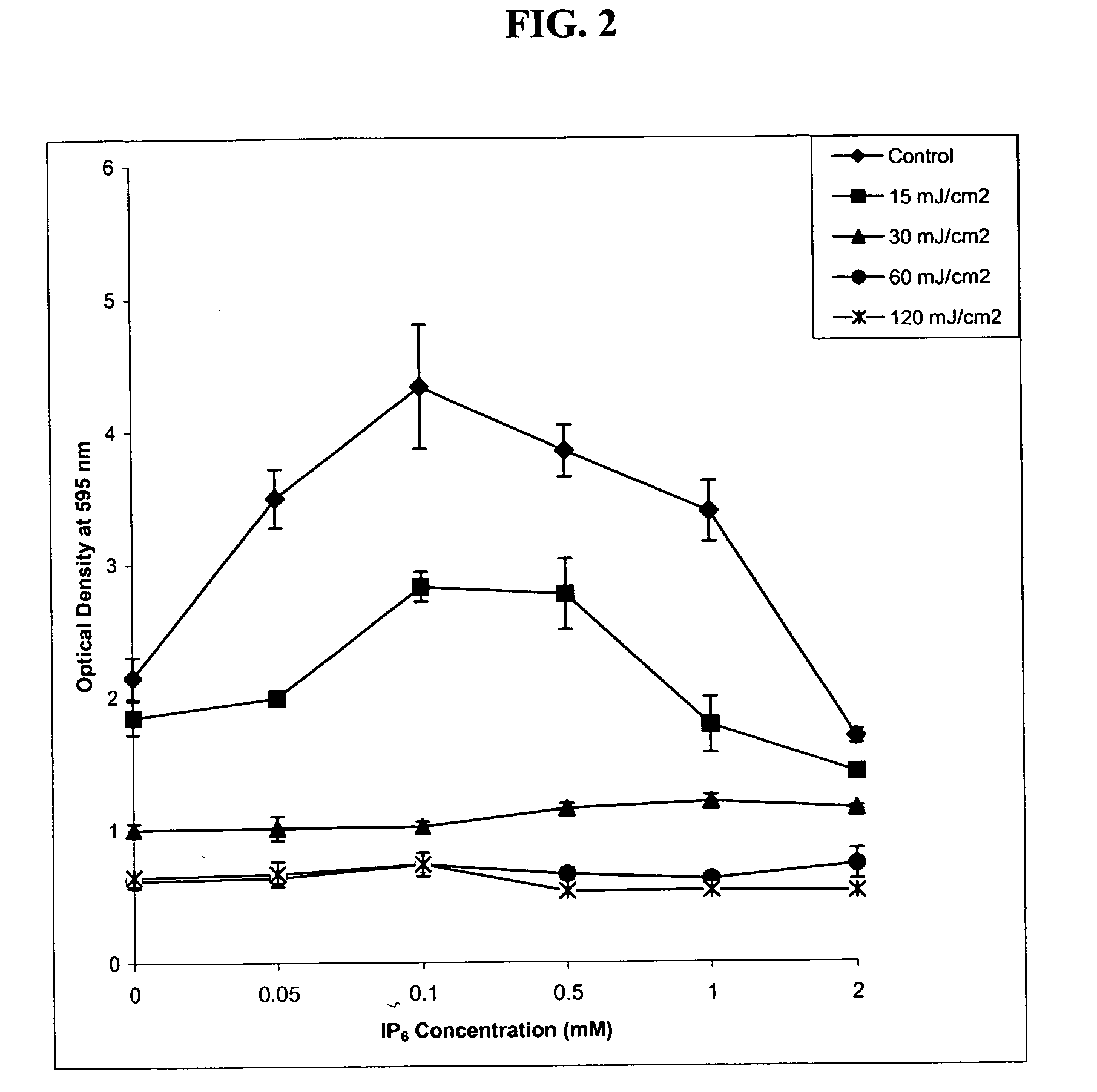Prevention of nuclear, solar, and other radiation-induced tissue damage
a radiation-induced tissue damage and nuclear technology, applied in the field of ionizing radiation, can solve problems such as uncontrolled doses, and achieve the effects of reducing cell attachment, increasing uvb intensities, and significant dose-dependent cell attachmen
- Summary
- Abstract
- Description
- Claims
- Application Information
AI Technical Summary
Benefits of technology
Problems solved by technology
Method used
Image
Examples
example 1
Improved Cell Viability by Administering Inositol / IP-6 Compounds Following Radiation Standard Procedures:
[0095]The human keratinocyte (HaCaT) cells were grown in Dulbecco's Modified Eagle's Medium containing 7 mg / L of inositol (38.8 μM), supplemented with 10% heat-inactivated fetal bovine serum, 1% L-glutamine, and 1% antibiotic (penicillin, streptomycin). Cells were maintained at 37° C. and 5% CO2. Na-IP-6 was diluted from a 100 mM stock solution to the required concentrations (0.05-2.0 mM) using cell culture medium as the diluent. UVB intensities of 15, 30, 60 and 120 mJ / cm2 were used, which was obtained by varying cell exposure time to UVB light (80% of light output is in 290-320 nm UVB range).
[0096]HaCaT cells were grown to approximately 80-90% confluency. 100 μL of 1×104 cells / mL HaCaT cells were seeded into each well of four 96-well plates. Cells were treated with IP-6 (0-2.0 mM), and on days 0, 1, 2, and 3, 100 μL of 1 mg / mL of aqueous MTT dissolved in DMEM media was added to...
example 2
The Effects of IP-6 and UVB Radiation on Attached Cells
[0100]5×104 HaCaT cells were seeded into each well of four 6-well tissue culture plates and incubated at 37° C. and 5% CO2 for 24 hours. One hour before UVB irradiation, two plates were treated with IP-6 (0 and 0.1 mM), one for IP-6 pre-treatment and the other for IP-6 pre-treatment and post-treatment. All four plates were then washed twice with PBS 1×, and a small amount of PBS 1× was added to the wells, which were irradiated at 30 mJ / cm2. After UVB exposure, PBS was removed from the wells and DMEM media was added to each well. IP-6 (0.05 and 0.1 mM) was then added to the plates labeled no UVB exposure, IP-6 post-treatment, and pre-treatment and post-treatment. The cells were then incubated (37° C. and 5% CO2) for 18 hours. Following incubation, the cells were washed 4 times with PBS 1× (pH 7.4), then fixed with 4.0% formaldehyde for 15 minutes, and stained with 0.5% aqueous crystal violet for at least 5 minutes. Excess crystal...
example 3
Effect of IP-6 and UVB Radiation on Apoptosis of HaCaT Cells.
[0103]HaCaT cells were plated in 60 mm tissue culture dishes for 24 hours. The cells were then either not exposed, or exposed, to 30 mJ / cm2 UVB radiation and treated immediately with 0, 0.5 mM, or 1.0 mM IP-6. Cells were harvested 6 and 18 hours after UVB exposure. 5 μL of RNase (DNase-free) was added to 106 cells / mL. The cell suspension was incubated at 37° C. for 30 minutes. The suspension was then chilled on ice (2-8° C.). 100 μL of PI was added to the cell suspension (Cellular DNA flow cytometric analysis kit, Roche Diagnostics, Indianapolis, Ind.). DNA quantitation was performed on the same day by flow cytometry using FACS.
[0104]At 6 hours following 30 mJ / cm2 UvB radiation, there was a significant increase in the G1 phase and a significant decrease in the S phase as compared to the non-UVB exposed control group, p<0.001. However, there was no significant difference in the G2M phase between the exposed and non-exposed ...
PUM
| Property | Measurement | Unit |
|---|---|---|
| Fraction | aaaaa | aaaaa |
| Fraction | aaaaa | aaaaa |
| Fraction | aaaaa | aaaaa |
Abstract
Description
Claims
Application Information
 Login to View More
Login to View More - R&D
- Intellectual Property
- Life Sciences
- Materials
- Tech Scout
- Unparalleled Data Quality
- Higher Quality Content
- 60% Fewer Hallucinations
Browse by: Latest US Patents, China's latest patents, Technical Efficacy Thesaurus, Application Domain, Technology Topic, Popular Technical Reports.
© 2025 PatSnap. All rights reserved.Legal|Privacy policy|Modern Slavery Act Transparency Statement|Sitemap|About US| Contact US: help@patsnap.com



